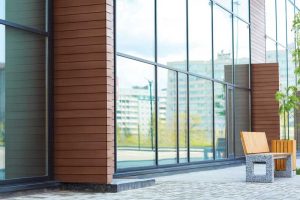
While manufacturing composite cladding requires a constant source of water, some manufacturers use a closed-loop system to maintain sustainability. A closed-loop system uses a reservoir to store and recycle the same water every day, preventing billions of gallons of water—enough to fill 5,300 Olympic-size swimming pools—from ending up in the waste stream.3
Performance/lifecycle
Doubling the life of a building essentially halves the environmental impacts of its construction, which is why the durability of a material, along with its performance, are crucial when considering its sustainability.
WPCs combine the best qualities of recycled wood—such as strength and low cost—with the long-lasting resilience of recycled plastic, which is less prone to water absorption and insect infestation. Blending these two materials together is the reason why WPCs last so long, and why they are sustainable from start to finish.
Unlike solid wood, the durable composite core of WPC cladding ensures exceptional resistance to rotting, cracking, insects, and decay. A three-sided cap layer protects against fading and staining, which is common with solid wood cladding, and it has a finished surface on both the top and bottom to further prevent water absorption.
Composite cladding also never needs sanding, staining, painting, or sealing. There are environmental dangers associated with volatile organic compounds (VOCs) released from stain and paint. VOCs are the leading cause of ground-level air pollution and indoor air pollution, which can adversely impact the health of building occupants.7 When solid wood is stained or painted to maintain its durability, it will then need to be refinished with more stain or paint every couple of years, which creates a continual cycle of chemical emissions. The chemicals used in treated wood are generally not good for humans either. Since composite cladding is highly durable and never needs to be stained or painted, it is free of these toxic chemicals and preservatives.
Further, when the WPC is finished being used as cladding, the material can be recycled into something new. Wood treated with chemicals, on the other hand, cannot be burned or recycled when its use as cladding is complete.
Performance of composite cladding
Compared with other building envelope materials, WPC stands apart as the most sustainable option—both in terms of durability and material makeup.
Wood Cladding
Appearance
Wood siding—including shiplap, tongue and groove, and board and batten—is prone to fading, chipping, and staining. It can also develop mold and mildew stains.
Installation
Wood siding requires multiple trades (carpenters, painters, and so on) to install and finish. The siding will need to be refinished (and sometimes repaired) every few years—which is a time-consuming process entailing scraping, sanding, pressure-washing, and re-staining or re-painting.
Durability
Wood splits, splinters, and is particularly affected by freeze/thaw cycles. Water absorption is dependent on the quality and age of the finish. If the siding is not maintained, the durability will be compromised.
Recycled content
Wood cladding contains no recycled content if purchased new. Some wood cladding is made from endangered hardwood species, which results in negative environmental repercussions.





Fantastic insights into the future of sustainable construction! This article beautifully highlights the benefits of composite cladding in achieving zero waste and enhancing design sustainability. Well-written and inspiring.